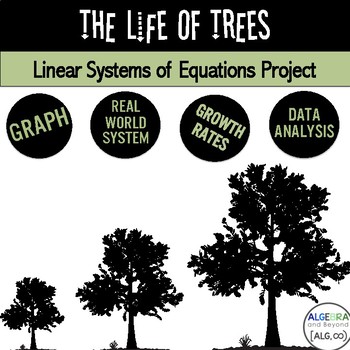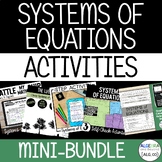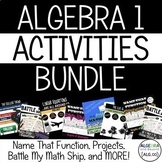Solve Systems of Equations Real World Project - Substitution & Graphing Activity
- Zip
What educators are saying
Also included in
- Are your students struggling to grasp the concepts of solving systems of equations by graphing, substitution, and elimination? Do you want to make the learning process more enjoyable while ensuring effective comprehension? Look no further than this Systems of Equations Mini-Bundle where students usePrice $10.50Original Price $17.75Save $7.25
- This bundle is a great addition to any Algebra curriculum! Includes many algebra concepts – one-step, two-step, multi-step, and absolute value equations and inequalities, linear equations, systems of equations, exponential functions, exponents, quadratics, and more! A diverse set of resources – selfPrice $130.00Original Price $226.50Save $96.50
Description
Connect math to real life in this Systems of Linear Equations Project. This project based learning activity is perfect for students to write a systems of linear equation, solve by using substitution or elimination, graph the solution, and analyze data. Plus, they have fun researching their very own tree to see how fast it will grow!!!
Check out the PREVIEW to see what skills are covered and more details of this fun project!!!
INCLUDES:
Note to Teacher
Project Handout (PDF file & 100% Editable PPT file)
- Part A & B: (2 versions for differentiation) Students research the growth of a tree and write an equation to represent the growth. Then, they determine when their tree will be the same height as my tree, which was planted five years ago. They find their solution using the substitution or elimination method.
- Part C: Create a graph to show the system.
- Part D: Analyze the results.
- Part E: Create a visual of the tree and some facts about the tree.
Answer Key: All 40 scenarios for the different growth rates has been calculated, including the possible solutions. Answers to all the analytical questions.
Rubric (PPT file): 100% editable
Student Sign-Up Sheet: Excel sheet for students to choose their tree and the growth rate
Example Visual (PDF file): An example of Part E to show students.
You can find more Real World Projects here:
Real World Linear Equations Project
Real World Quadratic Functions Project
Linear, Exponential, & Quadratic Regression Project
Exponential Regression Project | Cryptocurrency
Solving Absolute Value Inequalities Project
Real World Quadratic Regression Project
Math Review Project | Math Vlogger
∞∞∞∞∞∞∞∞∞∞∞∞∞∞∞∞∞∞∞∞∞∞∞∞∞∞∞∞∞∞∞∞∞∞∞∞∞∞∞∞∞∞∞∞∞∞∞
© Algebra and Beyond
This product is intended for personal use in one classroom only. For use in multiple classrooms, please purchase additional licenses.







